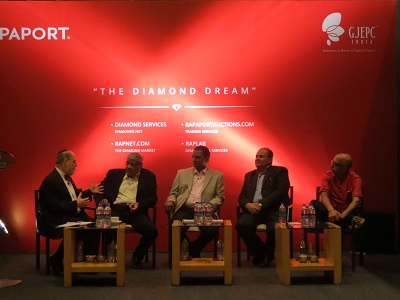|
|
Indian Jewelers Recognize Enormous Local Potential For Diamond Market
Aug 8, 2015 10:26 PM
By Avi Krawitz
|
|
|
RAPAPORT... Indian jewelry retailers recognized tremendous potential for local diamond consumption as they mulled ways to increase demand at the Rapaport Breakfast Seminar in Mumbai on Friday.
“The number of (wedding) proposals in India may be small but it’s going to explode 10 years from now,” said C.K. Venkataraman, CEO of jewelry at Titan Company, one of India’s largest jewelry retailers. “We need to take advantage of that opportunity.”
In his opening address to the seminar, Martin Rapaport, chairman of the Rapaport Group, noted that India has the largest population of young people in the world with more than 400 million people under the age of 20.
That has influenced a slow shift in cultural norms, which panelists at the seminar suggested have historically presented a barrier for growth in the industry. Such norms include the high number of arranged marriages in India, which has limited the opportunity for men to propose with a diamond engagement ring. Another was the tendency of jewelers to focus on gold jewelry which has resulted in some dependency of diamonds on the gold sector.
Panelists included Venkataraman, Ashok Minawala, board member of the All India Gems and Jewellery Trade Federation, Vipul Shah, Chairman of the Gem and Jewellery Export Promotion Council (GJEPC), Sanjay Kothari, convener of promotions, marketing and business development at the GJEPC, and Rapaport, who moderated the discussion.

Rapaport urged the industry to find a disruptor that would break those norms and increase consumer desire for diamonds. He stressed that diamonds need to stand on its own as a product and shouldn’t be a “little sister” to gold.
Minawala suggested that the diamond industry should partner with the gold industry in its marketing programs since when gold demand slows, the impact is felt in related products such as diamonds and gemstones. Panelists recognized that much of gold jewelry sales were related to the strong wedding culture in the country.
With gifting a large part of that wedding experience, Venkataraman noted that gold jewelry still dominates at weddings but the trend is slowly shifting to diamonds – although there is still much work to be done. He explained that an Indian wedding includes a number of events for which diamond jewelry would be appropriate and which women can wear on other occasions.
Venkataraman said that jewelers need to change their jewelry to adapt to the evolving taste of women in the country, both in terms of design and in-store presentation. Minawala agreed and cautioned that local jewelers tend to be flat sellers that don’t tap into the emotion that a diamond projects.
“The difference between trading and retailing is something the Indian industry doesn’t understand,” he said. “When a person walks into the store, the retailer needs to create emotion and not take it for granted. The emotion is what sells a diamond.”
Rapaport asked the panel if branding was the solution to selling that emotion, stressing that it’s not necessarily the product that sells a diamond but the idea behind the diamond that creates brand value.
Kothari advised that you can’t have branding without good product as consumers ultimately see through the marketing if the product is poor quality. Shah suggested that store branding is more important than product branding since that is the first thing the customer sees.
Venkataraman responded that a large number of women are not even coming into the store because the industry isn’t catering to them. “We need to create younger brands to bring them in,” he said.
While Indian consumers tend to seek out the investment value of their purchase, Minawala stressed that jewelers need to show both the emotional and investment value in their branding efforts. Panelists acknowledged that Indian millennials have more of a tendency to spend than previous generations but still look for the investment value in their purchases.
Rapaport noted that diamonds have an edge over other products since as they evoke emotion and have great value. Still, the seminar concluded that the industry needs to enhance the emotional aspect of its selling proposition.
As one jeweler from the audience noted, “The aspirational value of the diamond has diminished. Other products such as your iPhone or Rolex watches have it and that’s what has to be recreated in the diamond industry.”
|
|
|
|
|
|
|
|
|
|
Tags:
Avi Krawitz, diamonds, GJEPC, India, jewellery, Jewelry, Rapaport, Titan
|
|
|
|
|
|
|
|
|
|
|

|
|